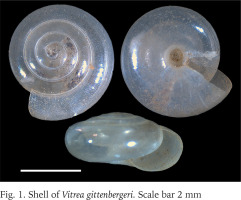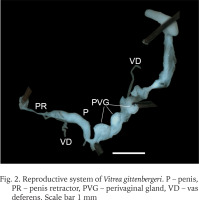INTRODUCTION
The genus Lindbergia Riedel, 1959 consists of nine species (MolluscaBase 2025), distributed in the islands of the Aegean and the nearby coastal mainland, specifically eastern Attiki, eastern Peloponnisos and southwestern Turkey. According to Riedel (1959) and Schileyko (2003), Lindbergia is distinguished from other European Pristilomatidae genera such as Vitrea Fitzinger, 1883 and Spinophallus Riedel, 1962, or Oxychilidae such as Mediterranea Clessin, 1880, by the following features of the reproductive system: a thick and elongated epiphallus, a penis sheath that embraces both the penis and the epiphallus, a penis lacking internal papillae or hooks, and a very short vagina, whereas the shell exhibits characteristics typical of Vitrea or Mediterranea. For this reason, references of the genus from southern Turkey – Lindbergia? karainensis Rähle et Riedel, 1987 – and from Kerkyra (Corfu) Island (Ionian Sea) – Lindbergia? gittenbergeri Pintér et Riedel, 1983 – which have been described only on empty shells without knowledge of their reproductive system should always be mentioned with a question mark (Riedel 1992). Accordingly, the species L. garganoensis Gittenberger et Eikenboom, 2006, from Puglia (southern Italy), which was originally described based solely on empty shells, was reassigned to Vitrea after the examination of its genitalia (Nardi et al. 2019).
On the island of Kerkyra, on the north side of Pantokratoras Mt. 450 m a.s.l. inside the cave Megali Grava (Peristerograva cave), E. Gittenberger collected empty shells that were described as L. gittenbergeri Pintér et Riedel, 1983 (Pintér & Riedel 1983: p. 101). One decade later the species was also found in another cave on Pantokratoras Mt., between Kassiopi and Agios Spyridonas (Riedel 1992).
The reproductive system of an adult specimen from the locus typicus was studied for the first time, allowing us to revise its taxonomic status. We assign the species within the genus Vitrea and compare it with other congeneric species present on Kerkyra and the nearby mainland.
MATERIAL AND METHODS
During a field trip to Kerkyra Isl. on 18th and 19th March 2025, two of the authors (G. G. and K. A. T.) visited Megali Grava cave (Peristerograva), located on the northern slope of Mount Pantokratoras at 450 m a.s.l., which constitutes the locus typicus of L. gittenbergeri. A total of 26 shells and a single live adult specimen of the species were collected; the latter represents the only known living individual of the species. Most specimens, including the live one, were found approximately 15 m from the cave entrance, on a steep slope with muddy soil. More shells were discovered in the central part of the cave, exclusively beneath rocks in areas where the soil was very moist. The living specimen was drowned for 24 hours in water and then preserved in 75% ethanol. After dissection and the study of the reproductive system the rest of the body was kept in pure ethanol for molecular study.
Seven of the largest shells were measured (Table 1) with stereoscope micrometer for shell diameter (SD), shell height (SH), number of whorls (Wh), following Kerney & Cameron (1979), diameter of the last and the penultimate whorls (LWhD and PUWhD respectively), aperture diameter (AD), aperture height (AH) and umbilicus diameter (UmD).
Table 1
Shell measurements in mm of adult Vitrea gittenbergeri. Abbreviations: SH – shell height, SD – shell diameter, LWhD – diameter of last whorl, PUWhD – diameter of penultimate whorl, AH – aperture height, AD – aperture diameter, Wh – number of whorls, UmD – umbilicus diameter

All collected samples (NHMC.50.17630.1–27; 1 alc., 26 shells) are stored in the malacological collection of the Natural History Museum of Crete.
RESULTS
Fresh shells are shiny and translucent (Fig. 1), while old shells are yellowish-white. Whorls 4.2 in average, weakly convex. Average shell diameter 4.1 mm and shell height 2.1 mm. The biggest specimen up to 4.5 mm in shell diameter and 2.4 mm in shell height. Shell periphery rounded. Last whorl diameter less than double of the penultimate. Aperture diameter is always bigger than aperture height. Umbilicus moderately wide 1/5–1/7 of the shell diameter. Spiral lines are not so visible as the radial irregular growth lines.
The reproductive system (Fig. 2) is typical of Vitrea (Schileyko 2003). Penis is elongated, without epiphallus. Penial retractor attached to penis at entrance of vas deferens and the latter enters penis apically. Vagina is elongate while the perivaginal gland consists possibly of three discontinuous lobes extending along the entire length of vagina. The proximal lobe is less distinct and requires confirmation through future dissections of further live specimens.
DISCUSSION
Pintér & Riedel (1983) in the description of L. gittenbergeri did not provide any measurements for the species, except of the maximum shell diameter and number of whorls. Also, in the figure of the shell drawing there is not a scalebar. However, our findings are in concordance with their description for the shell shape, colour, aperture and umbilicus, and our measurements coincide with those given by Welter-Schultes (2012). The only differences we found are related to the diameter of the last whorl, which is less than twice that of the penultimate whorl, and that the growth lines are more common and clearly visible than the spiral lines. In contrast to the shell, the reproductive system leaves no doubt that the species under study belongs to the genus Vitrea: vas deferens starts at the junction of penis and penis retractor, while the epiphallus is missing. A well-developed perivaginal gland is an additional diagnostic feature of Vitrea spp. (Schileyko 2003). Across numerous previously studied species, the perivaginal gland is consistently located in the proximal, middle, or distal part of the vagina and is also observed in the present species (Fig. 2). Remarkably, in V. gittenbergeri, the perivaginal gland is composed of two or three lobes, a condition unique within the genus.
Vitrea gittenbergeri comb. n. is the third species of the genus found on Kerkyra, together with V. contracta (Westerlund, 1871) and V. subrimata (Reinhardt, 1871). Additionally, on the opposite mainland, Greece (Ipeiros) and southern Albania, there are five more species: V. botterii (L. Pfeiffer, 1853), V. illyrica (A. J. Wagner, 1907), V. pygmaea (O. Böttger, 1880), V. selecta Pintér, 1972 and V. siveci Riedel et Velkovrh, 1976. Three of these species are morphologically very different: V. contracta and V. pygmaea are much smaller in shell diameter, while V. subrimata has a very narrow umbilicus. The remaining four species are more similar to V. gittenbergeri but with distinct differences. V. botterii is smaller in size (SD: 3–4 mm, SH: 1.3–2 mm, Wh: 4.5–5.3) and more densely coiled, while in the male part of the genitalia the penis has a characteristic swelling in the middle part (Riedel 1960). V. illyrica has the same shell diameter but is more depressed (SD: 3.9–4.4 mm, SH: 1.6–1.8 mm) (Riedel 1960), it has more whorls (Wh: 4.8–5.5) and wider umbilicus, 1/5 of SD, while in the female part of the genitalia the perivaginal gland is on the proximal part. V. selecta is smaller in size (SD: 3.3 mm, SH: 1.4 mm, Wh: 4.5–5), densely coiled and shell surface is almost smooth. V. siveci has larger shell (SD: 4.5–5.3 mm, SH: 2.5 mm, Wh: 5.3–5.5) and wider umbilicus, 1/5 of SD. According to Pintér & Riedel (1983) the shell of L. gittenbergeri is closer to V. siveci.
Following the present study and Nardi et al. (2019), the genus Lindbergia is largely restricted to the Aegean area. Exceptions include three species whose assignment to the genus requires verification: L.? karainensis from southern Turkey, L. parnonensis Gittenberger, 2008 from southeastern Peloponnese, and L. pageti Riedel, 1968, endemic to Crete, which should be regarded as of uncertain validity due to the unknown anatomy of their reproductive system. Thus, based on verified species, Lindbergia appears to be endemic to the Aegean area.



